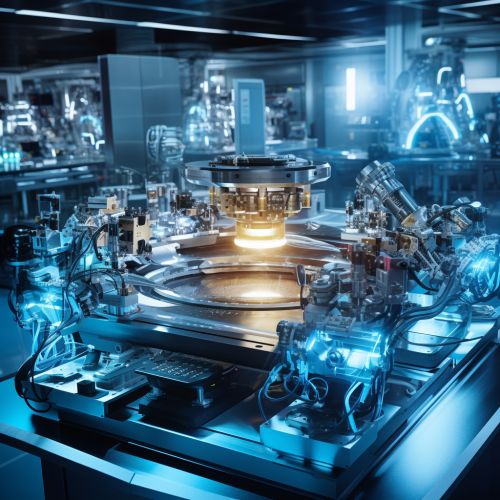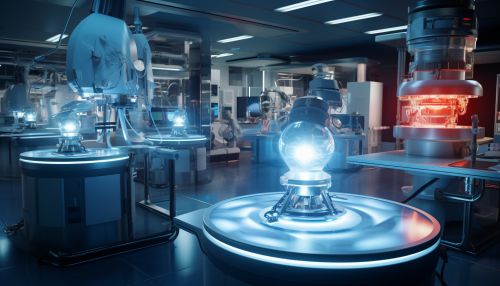Nanofabrication
Introduction
Nanofabrication refers to the design and manufacture of devices with dimensions measured in nanometers. One nanometer is one billionth of a meter, smaller than the wavelength of visible light and a hundred-thousandth the width of a human hair. As such, the rules of classical physics are not applicable, and devices made with nanofabrication operate according to the rules of quantum mechanics. Nanofabrication is used in producing transistors, memory chips, and other electronic and photonic devices.


Techniques
Nanofabrication encompasses several different techniques, including:
Photolithography
Photolithography is a process that uses light to transfer a geometric pattern from a photomask to a light-sensitive chemical on a substrate. This technique is commonly used in semiconductor manufacturing to pattern parts of a thin film or the bulk of a substrate.
Electron Beam Lithography
Electron Beam Lithography (EBL) is a method of etching semiconductors at a nanoscale level. It uses a focused beam of electrons to draw custom shapes on a surface covered with an electron-sensitive film.
Focused Ion Beam
Focused Ion Beam (FIB) is a technique used in materials science for site-specific analysis, deposition, and ablation of materials. FIB systems operate in a similar fashion to a scanning electron microscope (SEM) except, instead of a beam of electrons, FIB uses a focused beam of ions.
Nanoimprint Lithography
Nanoimprint Lithography (NIL) is a method of fabricating nanometer-scale patterns. It is a simple process with a straightforward stamping operation that can achieve pattern resolution beyond photolithography.
Applications
Nanofabrication has a wide range of applications in various fields such as:
Electronics
In the field of electronics, nanofabrication techniques are used to create smaller, faster, and more powerful microchips and circuits. This has led to significant advancements in computing and telecommunications.
Medicine
In medicine, nanofabrication is used in the development of drug delivery systems to target specific cells or tissues in the body, reducing the side effects and improving the efficacy of drugs.
Energy
Nanofabrication is also used in the energy sector, particularly in the development of more efficient solar cells and the creation of new energy storage systems.
Challenges and Future Directions
While nanofabrication has the potential to revolutionize many areas of technology, there are still many challenges to overcome. These include issues related to the cost and complexity of nanofabrication processes, the need for high precision and control, and the need for new materials and designs that can take full advantage of the unique properties of nanoscale devices. Despite these challenges, the future of nanofabrication looks promising with ongoing research and development in the field.
